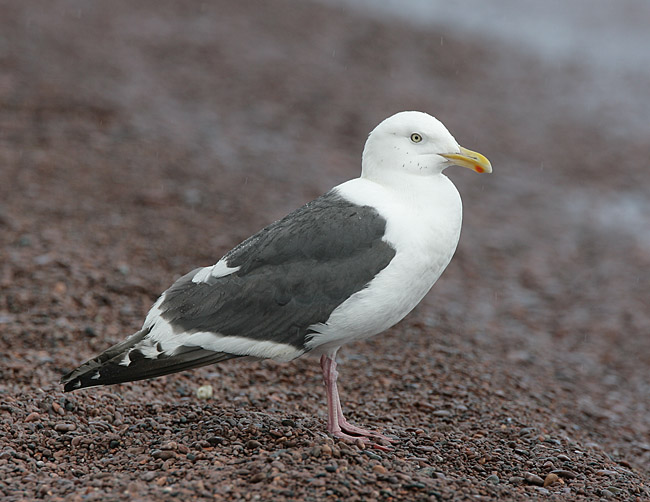
Close-up of Eyes Comments from BIRDWG01
David Cahlander
2006 July 22 - updated 2006 July 29

Grand Marais Gull (Slaty-backed Gull)
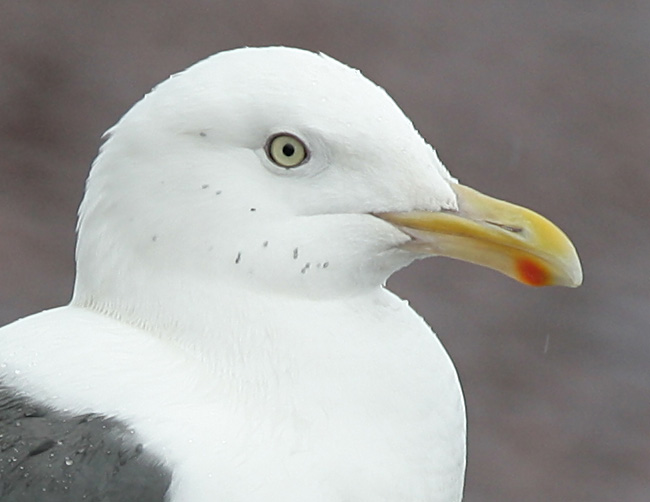
Close-up of head
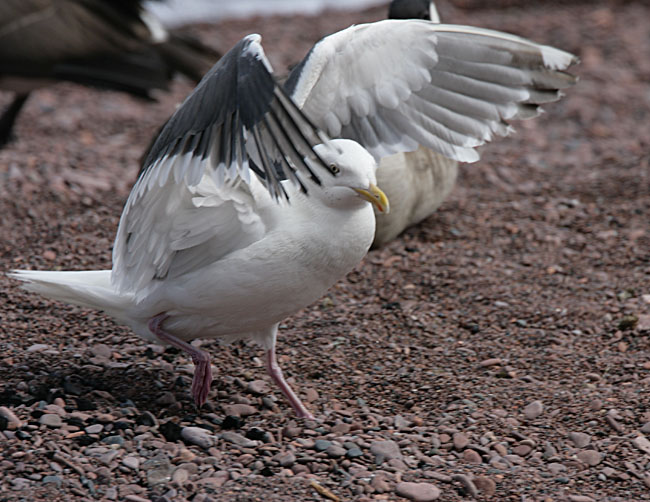
Underside of Wing
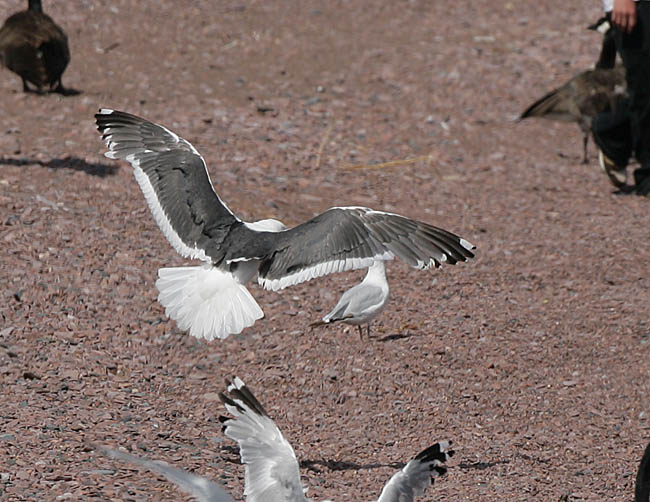
Back of wing in flight
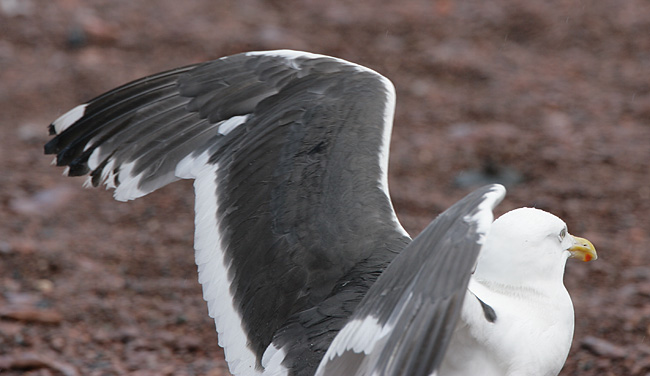
Back of wing, stretching
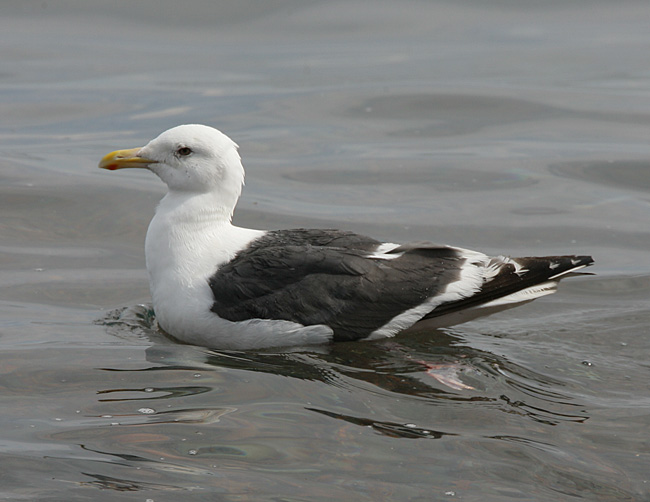
Bird in the water
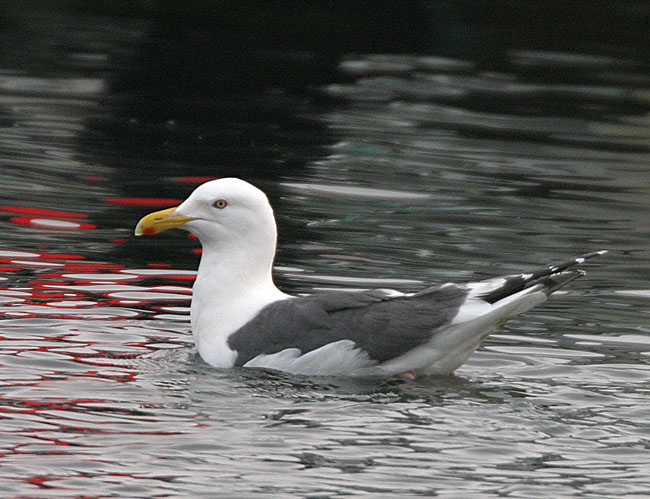
Slaty-backed Gull in Japan
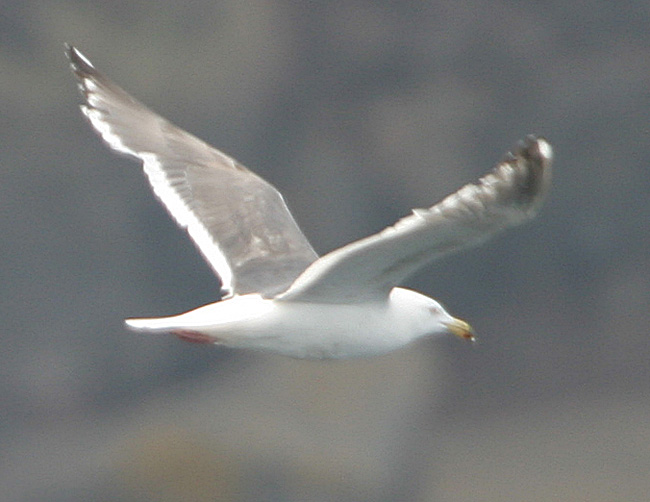
Slaty-backed Gull near Kamchatka, Russia
Close-up of eyes. None of my pictures show the red
outline for the eyes. These pictures were taken of the same bird on the
same day a little later than my pictures. Notice that the left eye has had
some damage due to a fight with several Herring Gulls.
Photos by Anthony X. Hertzel
David
I would have no hesitation in calling that bird a Slaty-backed Gull. The only feature that is a bit puzzling is the orbital ring, which is faded and washed out. You would think it would be bright at this time of year, but then again it is the post-breeding part of the year already. Reddish color is what you would expect on a fully formed orbital on a Slaty-backed. Everything looks near perfect to me. I have been telling people that this winter was likely a huge incursion of this species to the continent. I think we had something like 10-11 reported or photographed in my neck of the woods, 2 in Newfoundland, 1 in Ontario, I think at least 2 good ones in Texas, and colleagues from Field Guides told me that it was a boom year for Slaty-backs in Nome this summer.
Cheers
Al
Alvaro Jaramillo
chucao@coastside.net
Half Moon Bay, CA
Field Guides - Birding Tours Worldwide
http://www.fieldguides.com/home.htm
idzikoj@uwm.edu writes:
I just sent this to ryan brady in Wisc (ashland)-
Looks v good for Sb- not a GBBG hybrid by primary pattern and tert crescent
width-definitely not one of those pink legged Lessers- mantle color is variable
in these as well. With the apparent incursion of Sb into eastern canada and the
US this is no surprise- probably helped by dumps and warmer winters.
Interesting bird, note the worn white tail putting it at least at 4th summer,
but even with the wear in the primaries along with the obvious beginning of FF
moult- inner prim and secs- it appears that the old primaries lack a good
subterminal mirror one would expect for Sb- there is a lot of variation in this
pattern in adults and some conjecture that (also as in thayer's which has asian
affinities) the pattern "matures" with each complete moult with only older
birds, maybe 5th-6th year+ showing a hard string of pearls pattern- so perhaps
we can assume that this bird is a 4th summer, showing some subadult less than
perfect string of pearls pattern attained at its 4th winter (the brownish tinge
to the coverts perhaps supports this as well) and will look more "field guide"
by october- hope that the Minn RC does not get caught up on this.
ji
Looks totally excellent for a Slaty-backed Gull. Great photos.
Bruce Mactavish
St. John's, Newfoundland
Canada
bruce.mactavish1@nf.sympatico.ca
Greetings David
How amazing. Yes, that would be a Slaty-backed Gull. The bill is a bit heftier than average, but the legs are brighter, bill duller than a WEGU, and then there is the typical SBGU wing pattern.
A WEGU x GWGU would not be this dark mantled or dark primaried this time of year, nor would it have such a white eye.
Cheers
Steven Mlodinow SGMlod@aol.com
Looks perfect to me. Plus points include:
broad white fringe to the secondaries
white "half-moons" (string-of-pearls) on P5 to P8.
broad white fringe to the secondaries
Dick Newell <dick.newell@zen.co.uk>
Cambridge, UK
Dear David,
I'll preface my remarks by telling you that I've seen only two
definite SBGUs, plus a few possibles/probables (all in Texas).
However I am an earnest student of SBGU identification, and have
looked at more than 200 photos of them from Japan, Russia and Korea.
I think your bird must be a female SBGU. The only feature that I can
see that seems odd is the orbital ring color, as that is supposed to
be pinkish - look here:
http://vegae.hp.infoseek.co.jp/SbG01_03_13/SbG010313.html
- of course, this may be affected by the time of year (maybe the
bare parts become duller right after the breeding season; this may
also account for the legs being a bit less vivid than on late
Winter/Spring birds)
On the other hand, there is a good list of pro-SBGU features:
- very thick white trailing edge to secondaries
- very thick white tertial and scapular crescents
- obvious white subterminal spots on Ps 5-8 (the one the P8 is a bit
small and located a bit too close to the tip than typical, but you
can find pics of birds just like this at the Ujiharas' site)
- on Ps 10-7 a comparison of upper and underside shows the typical
pattern of black from above, pale gray from below, except that from
below P10 has a black extension back from the tip only on the inner
half of the feather - look at the pics on the Ujiharas' site and
you'll see that this is typical.
There was a SBGU invasion of sorts last winter, so I'm sure some of
these birds lingered into the breeding season, and will move south
with other large gulls that failed to breed.
Cheers,
Martin
David,
Interesting bird, for sure
While I admit to not having much experience with this species, I have done
quite a bit of studying over the last few months (sparked by having been
part of the discovery of 3 different individuals here in Newfoundland this
past winter -- the first records for the province, and only the 3rd to 5th
for the eastern seaboard). There seems to have been a movement of SBGU in
North America this year, although a summer record like this one is still a
huge find.
To my eye, your bird looks good for SBGU. Mantle shade, leg colour, the wide
tertial crescent, and developing string of pearls (to P8) all support the
identification. Its not clear in the photos, but I assume the bird was
similar to HEGU in size?? The head shape seems a little odd -- more
LBBG-like in some ways. Same with the bill - it appears a little small and
slight. Otherwise, this bird seems a much better fit for SBGU than anything
else, and I can't imagine any hybrid combination that would produce such a
combination of features (especially the "string of pearls").
It will be interesting to hear what others, with more experience, have to
say. Please keep us posted.
For comparison, a series of pictures of the three SBGUs from Newfoundland
this past winter are included below.
Cheers,
Jared Clarke
Adult - February 5 2006
http://birdingnewfoundland.20m.com/SBGU_ad.jpg
3rd winter - March 19 2006
http://birdingnewfoundland.20m.com/SBGU_1.jpg
http://birdingnewfoundland.20m.com/SBGU_2.jpg
http://birdingnewfoundland.20m.com/SBGU_3.jpg
Adult - April 25 2006
http://birdingnewfoundland.20m.com/photo.html
__________
Jared Clarke <jared_jjc@hotmail.com>
Basic Medical Sciences (Neuroscience), Faculty of Medicine
Memorial University of Newfoundland
St. John's, NL, Canada